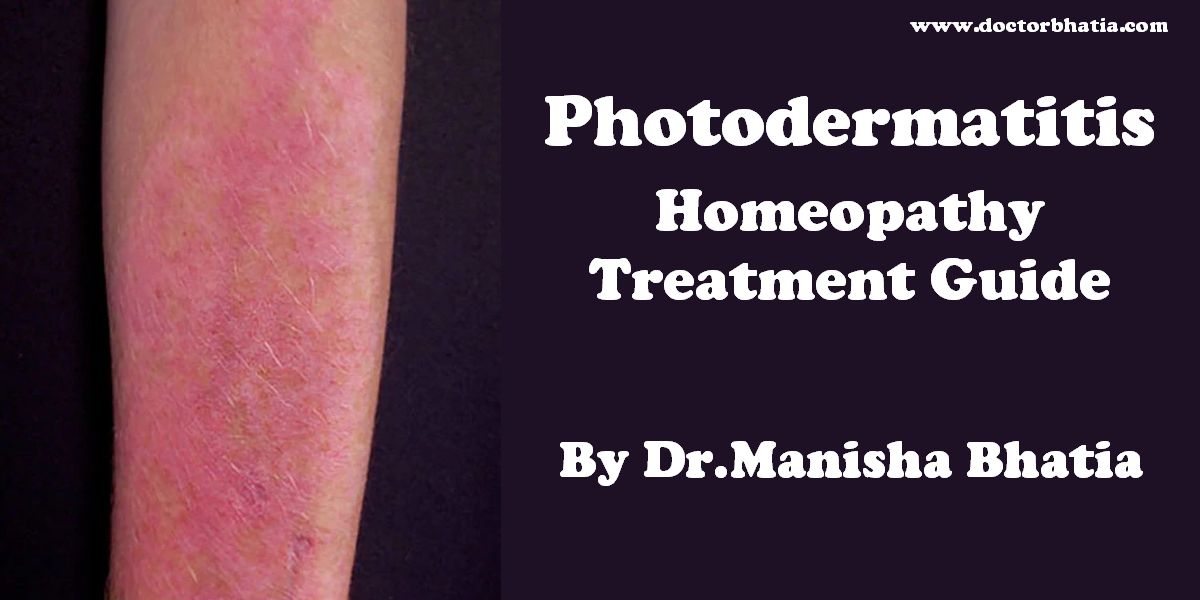Photodermatitis, or sometimes called by the nonscientific term sun poisoning, is a reaction of the skin to UV rays of the sun, or photoallergy. It may be caused by a medication that makes the skin more sensitive, a skin product (e.g. sunscreen containing PABA, certain fragrances), autoimmune conditions such as systemic lupus erythematosus (SLE) or a vitamin deficiency. Doctors can determine the presence of the disorder through a photo test.
Causes of Photodermatitis
Many medications cause sun sensitivity, including:
- psoralens, coal tars, photo-active dyes (eosin, acridine orange)
- musk ambrette, methylcoumarin, lemon oil (may be present in fragrances)
- PABA (found in sunscreens)
- salicylanilide (found in industrial cleaners)
- Hexachlorophene (found in some Rx antibacterial soaps)
- Contact with sap from Giant Hogweed. Common Rue (Ruta graveolins) is another phototoxic plant commonly found in gardens.
- Tetracycline antibiotics
- NSAIDs.
- Fluoroquinolone antibiotic: Sparfloxacin in 2% of cases.
- Pellagra
Photodermatitis can also be caused by plants. This is called phytophotodermatitis.
- Lime Oil
Symptoms of Photodermatitis
May result in swelling, a burning sensation, a red itchy rash sometimes resembling small blisters, and peeling of the skin. Nausea may also occur.
Prevention for Photodermatitis
Prevention includes avoiding exposure to the sun:
- Stay inside during the brightest hours of the day, from noon to 3 p.m.
- Cover up: wear long sleeves, slacks, and a wide-brimmed hat whenever harsh exposure is probable. Remember that cloud cover does not provide protection from UV rays.
- Avoid chemicals that may trigger a reaction (do not, however, stop taking medication without consulting a doctor).
- Wear sunscreen[1] at least factor 30 with a high UVA protection level.
- If the symptoms are severe, see a doctor.
Foods and treatment of Photodermatitis
The following foods or treatment may also help:
- Beta Carotene – found in carrots, not proven to be effective
- Omega-3 fatty acids – found in fish and flax seed
- Protein – will especially help individuals whose malnutrition may be a contributing factor.
- Vitamin B3, Vitamin C, Vitamin D, and Vitamin E
- Green tea – antioxidants
- Calendula
- Aloe – external use
- If pellagra is the cause, niacin is the specific treatment
Homeopathy Treatment for Photodermatitis
Keywords: homeopathy, homeopathic, treatment, cure, remedy, remedies, medicine
Homeopathy treats the person as a whole. It means that homeopathic treatment focuses on the patient as a person, as well as his pathological condition. The homeopathic medicines are selected after a full individualizing examination and case-analysis, which includes the medical history of the patient, physical and mental constitution, family history, presenting symptoms, underlying pathology, possible causative factors etc. A miasmatic tendency (predisposition/susceptibility) is also often taken into account for the treatment of chronic conditions. A homeopathy doctor tries to treat more than just the presenting symptoms. The focus is usually on what caused the disease condition? Why ‘this patient’ is sick ‘this way’. The disease diagnosis is important but in homeopathy, the cause of disease is not just probed to the level of bacteria and viruses. Other factors like mental, emotional and physical stress that could predispose a person to illness are also looked for. No a days, even modern medicine also considers a large number of diseases as psychosomatic. The correct homeopathy remedy tries to correct this disease predisposition. The focus is not on curing the disease but to cure the person who is sick, to restore the health. If a disease pathology is not very advanced, homeopathy remedies do give a hope for cure but even in incurable cases, the quality of life can be greatly improved with homeopathic medicines.
The homeopathic remedies (medicines) given below indicate the therapeutic affinity but this is not a complete and definite guide to the homeopathy treatment of this condition. The symptoms listed against each homeopathic remedy may not be directly related to this disease because in homeopathy general symptoms and constitutional indications are also taken into account for selecting a remedy. To study any of the following remedies in more detail, please visit the Materia Medica section at Hpathy.
None of these medicines should be taken without professional advice and guidance.
Homeopathy Remedies for Photodermatitis :
nat-m., sol.
References
- ^ AAD – The Sun and Your Skin, “Allergic Reactions” section


